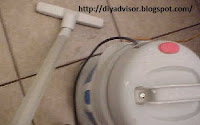 |
| Fig.1 Painter's cap |
Supplies and Tools:
Ladder 6 feet
Paint brush
Paint can opener (free at The Home Depot)
Paint edger
Painter's hat
Paint roller and paint frame
Paint tray with disposable plastic insert
Painter's tarp
Primer paint (Kilz white)
Rags (pick up paint drips)
Vacuum Cleaner with Drywall bag
Mr. Johnson had called a plumber to repair a leaking copper pipe. The damaged pipe had been leaking for a long time and the entire ceiling was soggy. The local plumber punctured the ceiling just enough to repair the copper tee pipe was replaced and soldered. Mr. Johnson called my repair service to repair and paint his dining room ceiling. The catch was the job had to be done in one day because the family was leaving to New Mexico the next day.
This post shows the seven steps to prime and paint the dining room ceiling.
Step 1: Fig.1 shows a painter's hat.
Step 2: Fig.2 and fig.3 shows more tarps protecting the furniture from paint drops.
 |
| Fig.2 Cover everything |
 |
| Fig.3 Cover lamps with tarp |
Note: Kilz primer was chosen because it dries in 30 minutes.
 |
| Fig.4 Kilz 2 primer |
 |
| Fig.5 Opening the Kilz primer |
 |
| Fig.6 paint tray with wall edger |
 |
| Fig.7 shows the ceiling is flat and ready for texture |
Step 5: Fig.8 and fig.9 shows the ceiling being painted with semi-gloss paint. The paint was provided by the customer.
 |
| Fig.8 rolling the ceiling |
 |
| Fig.9 Semi-Gloss paint |
 |
| Fig.10 Ceiling painted |
 |
| Fig.11 Vacuum cleaner |
How To Repair a Dining Room Ceiling Leak:
- Part 1 of 2 - Ceiling Repair
- Part 2 of 2 - Priming and Painting
Update: DIY Advisor has New blogs check them today:
- Handyman Blog: DIY Advisor
- DIY Advisor Sitemap
- Food Blog: From Kiwis To Pistachios
- Food Blog Sitemap
- Tool Blog: DIY Advisor Toolbox
- Tool Blog Sitemap
- Artwork Blog: Light in Dark Artwork
- Artwork Blog Sitemap
- Class-A Tests: DIY Class-A Drivers License Tests
- Class-A Tests Sitemap: Class-A Sitemap
- DIY Poem: DIY Poem Meter Blog
- DIY Poem Sitemap: DIY Poem Sitemap
- Cookie Alert: European Union laws requires that you know that this blog uses cookies. If you are concerned about this please click here to see how Google uses this information.
Note: The DIY Advisor assumes no liability for omissions, errors or the outcome of any jobs. The reader must always exercise reasonable caution, follow current codes and regulations that may apply, and is urged to consult with a licensed contractor if in doubt about any steps on these posts. All names were changed to protect client's privacy. DIY Advisor. Reproduction of site content including photos without permission prohibited. All rights reserved. © Copyright 2011-



















